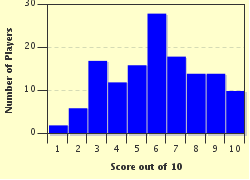Quiz Answer Key and Fun Facts
1. Members of the genus 'Taurotragus', what are these large antelopes native to the African savannah?
2. Also known as a spiny anteater, what is the alternative name of this native of Australia and New Guinea?
3. Part of the 'Utility' group as defined by the Kennel Club, this dog breed, noted for its long, thick double coat, is known to be a wonderful companion that makes strong bonds with its family and is relatively easy to train. Which breed is this?
4. This large flightless bird is the only extant member of the 'Dromaius' genus. Who is this Australian native?
5. 'Dasypeltis scabra' is a non-venomous snake native to sub-Saharan Africa and the Middle East. The picture may provide a clue to why he is known by which name?
6. Two species in the 'Mirounga' genus, these large ocean-going creatures are found from the Pacific coast of Canada to New Zealand.
7. Also sometimes called a "wisent", this is a species in the 'Bovinae' sub-family of medium to large ungulates.
8. Capable of reaching speeds of 30 mph, this is the fastest of all domestic cat breeds. This and the Bahraini Dilmun are also the only natural spotted domesticated breeds. Which breed of cat is this?
9. Also known as a candlefish, this small migratory ocean fish, is a member of the smelt family native to the Pacific coast of North America. Which species is this?
10. We finish with everyone's favourite pachyderm (literally "thick skin"). I'm not going to ask you to identify this one, though... African elephants have the longest gestation period (hardly surprising, really) of any mammal, so just tell me how long the mother carries that not-so-little baby around inside her...
Source: Author
EnglishJedi
This quiz was reviewed by FunTrivia editor
rossian before going online.
Any errors found in FunTrivia content are routinely corrected through our feedback system.


